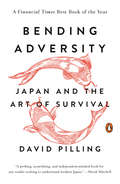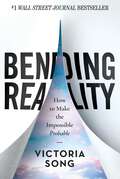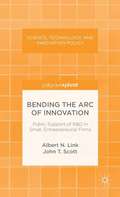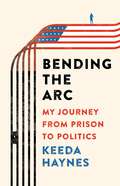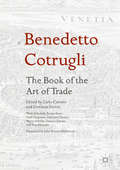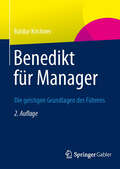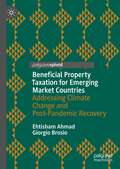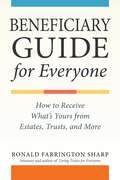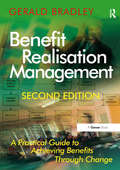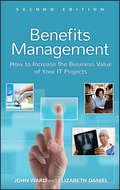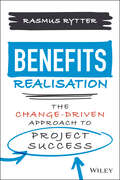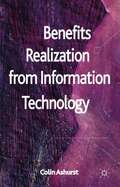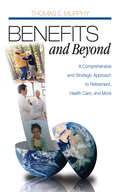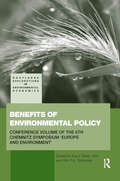- Table View
- List View
Bending Adversity: Japan and the Art of Survival
by David Pilling"[A]n excellent book..." --The EconomistFinancial Times Asia editor David Pilling presents a fresh vision of Japan, drawing on his own deep experience, as well as observations from a cross section of Japanese citizenry, including novelist Haruki Murakami, former prime minister Junichiro Koizumi, industrialists and bankers, activists and artists, teenagers and octogenarians. Through their voices, Pilling's Bending Adversity captures the dynamism and diversity of contemporary Japan.Pilling's exploration begins with the 2011 triple disaster of earthquake, tsunami, and nuclear meltdown. His deep reporting reveals both Japan's vulnerabilities and its resilience and pushes him to understand the country's past through cycles of crisis and reconstruction. Japan's survivalist mentality has carried it through tremendous hardship, but is also the source of great destruction: It was the nineteenth-century struggle to ward off colonial intent that resulted in Japan's own imperial endeavor, culminating in the devastation of World War II. Even the postwar economic miracle--the manufacturing and commerce explosion that brought unprecedented economic growth and earned Japan international clout might have been a less pure victory than it seemed. In Bending Adversity Pilling questions what was lost in the country's blind, aborted climb to #1. With the same rigor, he revisits 1990--the year the economic bubble burst, and the beginning of Japan's "lost decades"--to ask if the turning point might be viewed differently. While financial struggle and national debt are a reality, post-growth Japan has also successfully maintained a stable standard of living and social cohesion. And while life has become less certain, opportunities--in particular for the young and for women--have diversified. Still, Japan is in many ways a country in recovery, working to find a way forward after the events of 2011 and decades of slow growth. Bending Adversity closes with a reflection on what the 2012 reelection of Prime Minister Shinzo Abe, and his radical antideflation policy, might mean for Japan and its future. Informed throughout by the insights shared by Pilling's many interview subjects, Bending Adversity rigorously engages with the social, spiritual, financial, and political life of Japan to create a more nuanced representation of the oft-misunderstood island nation and its people.The Financial Times"David Pilling quotes a visiting MP from northern England, dazzled by Tokyo's lights and awed by its bustling prosperity: 'If this is a recession, I want one.' Not the least of the merits of Pilling's hugely enjoyable and perceptive book on Japan is that he places the denunciations of two allegedly "lost decades" in the context of what the country is really like and its actual achievements."The Telegraph (UK)"Pilling, the Asia editor of the Financial Times, is perfectly placed to be our guide, and his insights are a real rarity when very few Western journalists communicate the essence of the world's third-largest economy in anything but the most superficial ways. Here, there is a terrific selection of interview subjects mixed with great reportage and fact selection... he does get people to say wonderful things. The novelist Haruki Murakami tells him: "When we were rich, I hated this country"... well-written... valuable."Publishers Weekly (starred):"A probing and insightful portrait of contemporary Japan."
Bending Reality: How to Make the Impossible Probable
by Victoria SongBending Reality is the innovative process used by billionaires, tech leaders, and the world&’s most successful people to make the impossible . . . probable.Victoria Song teaches readers how to unlock the hidden power within their bodies to get what they want. After achieving success but lacking fulfillment as a student at Yale University and Harvard Business School, and then as a Forbes 30 Under 30 Venture Capitalist, Victoria set off on an unusual quest to study, train, and work with more than 24 of the best coaches, therapists, and healers in the world. She then deployed the skills and tools she&’d learned with a diverse group of the world&’s highest performers. Through it all, she&’s discovered the codes that enable her clients to bend reality toward the directions they want. By accessing this extraordinary ability, Victoria&’s clients have sold a company for 4 billion dollars, grown revenue 1,000% during a pandemic, and pivoted to design a more effective COVID-19 vaccine. Victoria reveals the meta-framework behind peak performance, self-development, therapy, and meditation that is accessible for all. Whether you&’ve studied these areas closely or this is the first book you&’ve read on this topic, you&’ll have a front row seat to how the world&’s elite use this knowledge to achieve more while doing less. In this fast-paced guide to success, you will learn how to: Bend reality by mastering two states of being that most people aren&’t even aware of. Navigate change and face the unknown like the greatest leaders. Access creative downloads that artists, musicians, and geniuses receive. Make your own luck—there&’s literally a recipe! Find your unique &“zone of genius&” and live from it every day. Packed with powerful tools and exercises, Bending Reality will move you beyond intellectual understanding to embodiment. This is not another mindset book. You&’re ready for Bending Reality if you realize it&’s time to go beyond the mind and harness the full capacity of your consciousness to make quantum leaps in every area of your life. After learning how to bend reality, you will no longer need to memorize rules, tips, or tricks, but you will embody the essence of a remarkable leader who can make the impossible—probable.
Bending the Arc of Innovation: Public Support of R&D in Small, Entrepreneurial Firms
by Albert N. Link John T. ScottBending the Arc of Innovation offers a theoretical model of the effects of the SBIR program
Bending the Arc: My Journey from Prison to Politics
by Keeda J. HaynesA searing exposé of the profound failures in our justice system, told by a woman who has journeyed from wrongfully accused prisoner to acclaimed public defender Keeda Haynes was a Girl Scout and a churchgoer, but after college graduation, she was imprisoned for a crime she didn&’t commit. Her boyfriend had asked her to sign for some packages—packages she did not know were filled with marijuana. As a young Black woman falsely accused, prosecuted, and ultimately imprisoned, Haynes suffered the abuses of our racist and sexist justice system. But rather than give in to despair, she decided to fight for change. After her release, she attended law school at night, became a public defender, and ultimately staged a highly publicized campaign for Congress. At every turn of her unlikely story, she gives unique insights into the inequities built into our institutions. In the end, despite the injustice she endured, she emerges convinced that ours can become a true second-chance culture.
Bending the Law of Unintended Consequences: A Test-Drive Method for Critical Decision-Making in Organizations
by Richard M. AdlerThis title provides managers, executives and other professionals with an innovative method for critical decision-making. The book explains the reasons for decision failures using the Law of Unintended Consequences. This account draws on the work of sociologist Robert K. Merton, psychologists Amos Tversky and Daniel Kahneman, and economist Herbert Simon to identify two primary causes: cognitive biases and bounded rationality. It introduces an innovative method for “test driving” decisions that addresses both causes by combining scenario planning and “what-if” simulations. This method enables professionals to learn safely from virtual mistakes rather than real ones. It also provides four sample test drives of realistic critical decisions as well as two instructional videos to illustrate this new method. This book provides leaders and their support teams with important new tools for analyzing and refining complex decisions that are critical to organizational well-being and survival.
BeneFactors: Why Some Fundraising Professionals Always Succeed
by Joshua M. Birkholz Amy S. LampiOvercome contemporary fundraising challenges and equip your non-profit or charity to meet the digital age head-on Contemporary fundraisers and development professionals are meeting a new and challenging set of obstacles as they go out into the world and attempt to raise money for their causes and organizations. In BeneFactors: Why Some Fundraising Professionals Always Succeed, a team of veteran philanthropy strategists and consultants delivers an exciting and practical playbook for modern fundraising that can be deployed in a variety of charitable and non-profit organizations and settings. You'll explore the eight factors you must master to exceed your fundraising goals in the modern era. In the book, you'll discover: Strategies for navigating the digital fundraising transformation and how to guide your digital donors through the giving process How to use data science and predictive analytics to inform your decision-making process and find better results Ways to banish excessive risk aversion and uncover a boldness you didn&’t know you had in you An extraordinary and insightful handbook to fundraising in the digital age, BeneFactors: Why Some Fundraising Professionals Always Succeed is sure to find its way onto the bookshelves of board members, development professionals, and other leaders of fundraising teams and organizations.
Beneath the China Boom: Labor, Citizenship, and the Making of a Rural Land Market
by Julia ChuangFor nearly four decades, China’s manufacturing boom has been powered by the labor of 287 million rural migrant workers, who travel seasonally between villages where they farm for subsistence and cities where they work. Yet recently local governments have moved away from manufacturing and toward urban expansion and construction as a development strategy. As a result, at least 88 million rural people to date have lost rights to village land. In Beneath the China Boom, Julia Chuang follows the trajectories of rural workers, who were once supported by a village welfare state and are now landless. This book provides a view of the undertow of China’s economic success, and the periodic crises—a rural fiscal crisis, a runaway urbanization—that it first created and now must resolve.
Benedetto Cotrugli – The Book of the Art of Trade: With Scholarly Essays from Niall Ferguson, Giovanni Favero, Mario Infelise, Tiziano Zanato and Vera Ribaudo
by Carlo Carraro Giovanni FaveroThis is the first English translation of Benedetto Cotrugli's The Book of the Art of Trade, a lively account of the life of a Mediterranean merchant in the Early Renaissance, written in 1458. The book is an impassioned defense of the legitimacy of mercantile practices, and includes the first scholarly mention of double-entry bookkeeping. Its four parts focus respectively on trading techniques, from accounting to insurance, the religion of the merchant, his public life, and family matters. Originally handwritten, the book was printed in 1573 in Venice in an abridged and revised version. This new translation makes reference to the new critical edition, based on an earlier manuscript that has only recently been discovered. With scholarly essays placing Cotrugli's work into historical context and highlighting key themes, this volume is an important contribution to our understanding of the origins of management and trade practices.
Benedikt für Manager: Die geistigen Grundlagen des Führens
by Baldur KirchnerWas hat Benedikt Führungskräften und Managern heute zu sagen?Benedikt von Nursia gründete im 6. Jahrhundert den Benediktinerorden und wurde durch seine vorbildliche Lebensweise und durch die Regel, die er für seine Mönchsgemeinschaft zusammenstellte, zu einer Leitfigur. Das Geistesgut des Benediktinischen ist für das abendländische Kulturleben prägend geworden. Das zeitlose Buch der Tugenden - zum ersten Mal vor knapp 20 Jahren erschienen - regt den Leser auch heute an zum Nachdenken über seine eigene Wesenstiefe, seine Haltung dem Leben gegenüber und seinen persönlichen Lebensstil. Es bietet vielfältige Anregungen für eine wirklich glaubwürdige und überzeugende Führungskultur. Nun in der 2. Auflage mit einem neuen Vorwort und einigen Ergänzungen.
Beneficial Ownership and Legal Responsibility: Concealment, Avoidance and Impunity (The Law of Financial Crime)
by Paul BeckettThis book explores the connection between ownership, on one hand, and immunity from legal responsibility, on the other. It presents a definition of the concept of beneficial ownership, the reasons for its concealment, and failures in international legal structures and arrangements. Globally, States confront complex criminality, such as corruption, tax evasion, doctrinal fanaticism, trafficked slaves, terrorism and, war. At the personal level, men and women may seek to escape their creditors, to disinherit unwanted heirs, to cheat divorced partners, and to appear straightforward when this is not the case. The response of politicians and regulators has been a global State initiative to identify beneficial owners via public registers to promote transparency and accountability. Yet, at the same time, there is an equally powerful global and personal counter-initiative to promote beneficial ownership avoidance. Where there is no owner, there is no accountability. This book examines what “ownership” means in legal terms across multiple legal systems and explains why singling out “ownership” as being pivotal to State and personal accountability is a strategy both flawed and disingenuous. It is argued that an apparent lack of political will coupled with shape-shifting definitions of “ownership” have resulted in tokenism. Particular attention is paid to those “orphan” structures which have evolved from standard models, or which have been designed for the purpose in each case of facilitating ownership concealment and avoidance. The author explains how the virtual world of the blockchain, crypto-assets and cryptocurrency, and virtual entities such as the Decentralised Autonomous Organisation (DAO), all of which elude legal classification, have opened a new world of possibilities. Applicable across all jurisdictions and legal systems, the book will be a valuable resource for academics, researchers, and policy-makers working in the areas of Financial Crime, Regulation, Compliance, Business, and Accountancy.
Beneficial Property Taxation for Emerging Market Countries: Addressing Climate Change and Post-Pandemic Recovery
by Ehtisham Ahmad Giorgio BrosioThis book presents a new approach to recurrent property taxation based on occupancy, size, and location, that will strengthen local governments. Reflecting on the concept of “beneficial property taxation” first proposed by Alfred Marshall, the political economy constraints faced by traditional property taxation are examined and compared with evidence for beneficial property tax seen in China, Mexico, and sub-Saharan Africa. The benefits of this form of taxation are highlighted in relation to the financing of local public services and infrastructure that are required for sustainable development. This book provides a policy-oriented look at property taxation that engages with the sustainable development goals and lay the foundations for a post-pandemic recovery. It will be relevant to researchers and policymakers interested in development economics and the governance of taxation.
Beneficiary Guide for Everyone: How to Receive What's Yours from Estates, Trusts, and More
by Ronald Farrington SharpLearn how to protect your rights, avoid delay or fraud, and ensure what is yours ends up in the right place. TThe primary reason people take the time to write a will or create a trust is not for their own sake. It is to be sure that the legal process for their beneficiaries is simple, quick, and fair. The goal is to reflect not just their wishes but also to be mindful of the expectations and needs of those left behind.Beneficiary Guide for Everyone is a step-by-step handbook on how to make and execute these decisions to get the maximum benefit. The first part covers the perspective of the planner: choosing how to leave your assets to your chosen beneficiaries, while simplifying complicated legal options, definitions, and concepts. The next covers how beneficiaries should approach the process so that assets are distributed with minimum delays and complications.Using clear language and avoiding legalese, author and lawyer Ronald Farrington Sharp simplifies complex topics. Chapters are supplemented with Q&A features to answer some common questions friends and clients have posed to him––and to which readers are likely to also need answers.
Beneficios de Afiliados de Amazon
by Adidas WilsonCómo generar ingresos pasivos a través del programa sitios de afiliados de Amazon.
Benefit Corporation Law and Governance: Pursuing Profit with Purpose
by Frederick H. AlexanderCorporations with a ConscienceCorporations today are embedded in a system of shareholder primacy. Nonfinancial concerns—like worker well-being, environmental impact, and community health—are secondary to the imperative to maximize share price. Benefit corporation governance reorients corporations so that they work for the interests of all stakeholders, not just shareholders. This is the first authoritative guide to this new form of governance. It is an invaluable guide for legal and financial professionals, as well as interested entrepreneurs and investors who want to understand how purposeful corporate governance can be put into practice.
Benefit Realisation Management: A Practical Guide to Achieving Benefits Through Change
by Gerald BradleyThe first edition of Gerald Bradley's Benefit Realisation Management quickly established itself as the definitive, practical guide to using measures to track performance throughout the life of a project or programme; enabling organisations to eliminate wasted investment, realise more benefits and realise them earlier. The second edition takes you step-by-step through the benefits realisation process, explaining along the way, how to: * define your projects and programmes by mapping the benefits * produce a convincing and accurate business case * communicate the benefits and get all your stakeholders on board * agree the measures you will use to encourage the desired behaviours, to monitor progress and to assess the ultimate success of the project or programme * use the benefits realisation approach to understand and address the human aspects of the project, including resistance to change, training needs and new ways of working * integrate this approach into your organisation's culture and systems The second edition includes expanded guidance on benefits realisation for portfolio management and includes revisions to the original text along with additional case study examples. The text of the latest edition is now printed in four-colour which make the detailed and varied benefit maps throughout the text immediately more striking and comprehensible. The benefits realisation management methodology fits closely with existing programme and project management approaches such as MSP and Prince 2, making it appropriate for both public and private sector environments. If you are investing heavily in change management, IT infrastructure or project working, then this book is a must-read that will justify its price many times over.
Benefit Transfer of Environmental and Resource Values: A Guide for Researchers and Practitioners (The Economics of Non-Market Goods and Resources #14)
by John Rolfe Roy Brouwer Robert J. Johnston Randall S. RosenbergerThis book provides a comprehensive review of environmental benefit transfer methods, issues and challenges, covering topics relevant to researchers and practitioners. Early chapters provide accessible introductory materials suitable for non-economists. These chapters also detail how benefit transfer is used within the policy process. Later chapters cover more advanced topics suited to valuation researchers, graduate students and those with similar knowledge of economic and statistical theory and methods. This book provides the most complete coverage of environmental benefit transfer methods available in a single location. The book targets a wide audience, including undergraduate and graduate students, practitioners in economics and other disciplines looking for a one-stop handbook covering benefit transfer topics and those who wish to apply or evaluate benefit transfer methods. It is designed for those both with and without training in economics
Benefit-Cost Analysis
by Harry F. Campbell Richard P. C. BrownBenefit-Cost Analysis offers the perfect introduction to benefit–cost analysis. The book closely integrates the theory and practice of benefit–cost analysis using a spreadsheet framework. The spreadsheet model is constructed in a truly original way which contributes to transparency, provides a check on the accuracy of the analysis, and facilitates sensitivity, risk and alternative scenario assessment. A case study incorporating the various issues is progressively developed on a spreadsheet with the links between each stage thoroughly explained. The complete case study spreadsheet can serve as a template for the reader's own appraisal of projects in the field. In addition to the worked examples in the text some exercises are appended at the end of each chapter. For further information please visit http://www. uq. edu. au/economics/bca
Benefit-Cost Analysis of Air Pollution, Energy, and Climate Regulations (Elements in Public Economics)
by John D. Graham Kerry KrutillaThis element offers a review and synthesis of the research on economic methods for evaluating regulations that improve air quality, save energy, and reduce climate risks. The intended audience is regulators and other constituencies interested in the nexus between scholarship and practice; analysts in government agencies and research organizations; and academic scholars and their graduate students. Topics include the evolution of regulatory impact assessment in the OECD; cost estimation, including engineering, partial equilibrium, and general equilibrium approaches; benefit valuation, with an emphasis on the value of reducing risk of illness and premature mortality, and methods for pricing carbon emissions; discounting methods, and their relationship to carbon pricing; the distribution of regulatory costs and benefits; and uncertainty evaluation methods for addressing less and more fundamental uncertainty. Perspective on the relevance and limitations of current research is offered. This title is also available as Open Access on Cambridge Core.
Benefit-sharing in Environmental Governance: Local Experiences of a Global Concept (Earthscan Studies in Natural Resource Management)
by Louisa ParksTaking a bottom-up perspective, this book explores local framings of a wide range of issues related to benefit-sharing, a growing concept in global environmental governance. Benefit-sharing in Environmental Governance draws on original case studies from South Africa, Namibia, Greece, Argentina, and Malaysia to shed light on what benefit-sharing looks like from the local viewpoint. These local-level case studies move away from the idea of benefit-sharing as defined by a single international organization or treaty. Rather, they reflect different situations where benefit-sharing has been considered, including agriculture, access to land and plants, wildlife management, and extractives industries. Common themes in the experiences of local communities form the basis for an exploration of spaces for local voices at the international level in the Convention on Biological Diversity (CBD), often argued to be the most open arena to non-state actors, and therefore vital to how local voices may be included at the global level. The book analyzes the decisions of the CBD parties to produce an in-depth reflection on how this arena builds and delimits spaces for the expression of local community themes, and paths for local community participation including community protocols. The book then situates the bottom-up findings in the wider debate about global civil society and deliberative democracy in environmental governance. This interdisciplinary book will be of great interest to students and scholars of environmental politics, environmental law, political ecology and global governance, as well as practitioners and policymakers involved in multilateral environmental agreements.
Benefits Management
by John Ward Elizabeth DanielThe second edition of Benefits Management has been updated with current examples, further insights from experience and recent research. It shows how the enduring challenges achieving business value from information systems and technology projects can be addressed successfully. The approach, which is synthesized from best practices, sound theories and proven techniques from a range of management disciplines, is exemplified from the authors' extensive experience of working with a wide range of organizations. The book includes examples from a wide variety of projects including non-IT projects. The book is written in an accessible style, ideal for practicing managers, and includes check lists and templates for using the processes, tools and techniques and real-life case studies of their application and impacts.The book now also includes:International survey results that reinforce the importance of the topic, the key management issues and evidence of how the more successful organizations' practices are closely aligned with those described in the book.A Benefits Management Maturity diagnostic which enables organizations to understand the reasons for their current investment success levels and then how to increase them.Discussion of the role and contribution Project Management Offices (PMOs): how they can improve the delivery of value IT projects.Further practical advice and guidance on Program and Portfolio Management, including findings from the authors' recent research in several large organizations.
Benefits Realisation: The Change-Driven Approach to Project Success
by Rasmus RytterRealise the full benefits potential from your change projects For most managers in steering committees of PMOs (Project Management Office) most projects are costly in both time and money, and they often only reach a fraction of the expected benefits. In Benefits Realisation: The Change-Driven Approach to Project Success, renowned benefits realisation expert, speaker, and consultant Rasmus Rytter introduces a new approach to change projects where benefits realisation defines the design of the project and how it’s led. Once the project’s benefits have been defined, the key question for the project to answer is: ‘How might we help our colleagues change their behaviour? Thus, identifying behavioural change as the key driver of benefit realisation. Step by step, the book guides you on how to approach both benefit realisation and behavioural change, as well as explain how it builds on the project and portfolio practices (or SAFe (Scaled Agile Framework)) you are already using. Benefits Realisation also offers: Elaborate real-life case studies and examples that show the application of the new approach to benefits realisation and change on different projects Easy to use posters, playbooks, and facilitation guides for the most important activities and workshops Effective strategies for using benefits realisation to minimise project cost Compelling possibilities for executives to make far better strategic prioritization decisions based on credible data for project benefits and the real cost of changePerfect for project managers, change managers, PMO professionals, and managers using agile frameworks, Benefits Realisation will also earn a place in the libraries of executives and other business leaders at all levels of your organisation.
Benefits Realization Management: Strategic Value from Portfolios, Programs, and Projects (Best Practices in Portfolio, Program, and Project Management)
by Carlos Eduardo SerraBenefits realization management (BRM) is a key part of governance, because it supports the strategic creation of value and provides the correct level of prioritization and executive support to the correct initiatives. Because of its relevance to the governance process, BRM has a strong influence over project success and is a link between strategic planning and strategy execution. This book guides portfolio, program, and project managers through the process of benefits realization management so they can maximize business value. It discusses why and how programs and projects are expected to enable value creation, and it explains the role of BRM in value creation. The book provides a flexible framework for: Translating business strategy drivers into expected benefits and explains the subsequent composition of a program and project portfolio that can realize expected benefits Planning the benefits realization expected from programs and projects and then making it happen Keeping programs and projects on track Reviewing and evaluating the benefits achieved or expected against the original baselines and the current expectations. To help project, program, and portfolio managers on their BRM journey, as well as to support business managers in executing business strategies, the book identifies key organizational responsibilities and roles involved in BRM practices, and it provides a simple reference that can be mapped against any organizational structure. A detailed and comprehensive case study illustrates each phase of the BRM framework as it links business strategy to project work, benefits, and business value. Each chapter ends with a series questions that provide a BRM self-assessment. The book concludes with a set of templates and detailed instructions to ensure successful deployment of BRM.
Benefits Realization from Information Technology
by Colin AshurstDrawing on the author's recent and ongoing research this book explores how to build the organizational capability to realise the strategic potential of information technology. It tackles the gap between theory and practice and how to gain wider adoption of successful socio-technical and benefits-driven approaches to investments in IT.
Benefits and Beyond: A Comprehensive and Strategic Approach to Retirement, Health Care, and More
by Thomas E. MurphyBenefits and Beyond: A Comprehensive and Strategic Approach to Retirement, Health Care, and More provides readers with a variety of interdisciplinary principles and tools, including labor economics, human resources strategy, tax policy, metrics, and actuarial science. Rather than training students in the details of current benefits offerings, this text prepares students to deal with the future evolution of benefit designs and policy. Numerous cases, examples, and exercises engage readers and help them master the content.
Benefits of Environmental Policy: Conference Volume of the 6th Chemnitz Symposium 'Europe and Environment' (Routledge Explorations in Environmental Economics)
by Dirk Rübbelke Klaus Dieter JohnEnvironmental policy may produce effects which go beyond the scope of the specific policy’s initial aim. Reforestation, for example, generates positive benefits not only in the shape of climate protection but also in the shape of the combat of biodiversity loss and it may also raise the attractiveness of a region for tourists. There are several examples of environmental policies, generating initially unintended co-effects. These co-effects are not always positive, of course. This book addresses the wide range of (co-)effects associated with environmental policies which may increase or decrease the attractiveness of these policies. Therefore, the book’s scope goes beyond the standard economic analyses, which regularly postulate a specific cause-and-effect chain. The complexity and wide range of benefits is investigated from different perspectives and by means of different methodologies. Among the environmental policies discussed are climate mitigation policies as well as adaptation policies. The inclusion of all relevant effects of environmental policy (and therefore not only of the primarily intended effects) tends to have a strong impact on the efficient policy design. The areas which are covered by the book will be of great interest mainly for economists (environmental economics, ecological economics), ecologists and political scientists as well as practitioners, scientists and policy makers.
